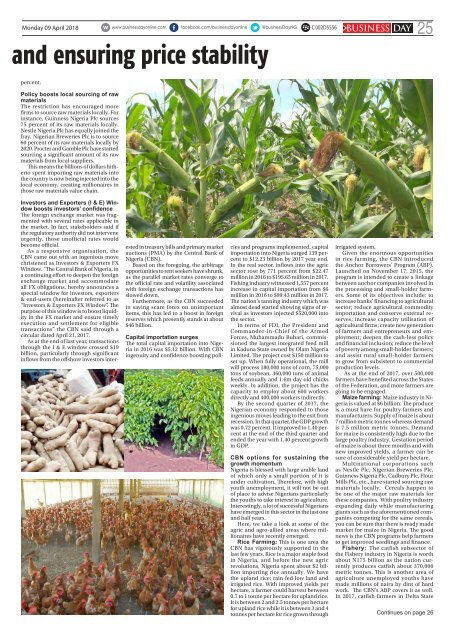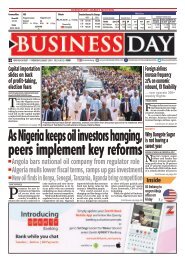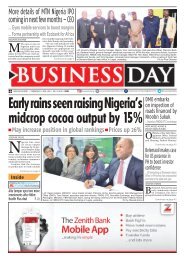BusinessDay 09 Apr 2018
Create successful ePaper yourself
Turn your PDF publications into a flip-book with our unique Google optimized e-Paper software.
Monday <strong>09</strong> <strong>Apr</strong>il <strong>2018</strong><br />
C002D5556<br />
BUSINESS DAY<br />
25<br />
and ensuring price stability<br />
percent.<br />
Policy boosts local sourcing of raw<br />
materials<br />
The restriction has encouraged more<br />
firms to source raw materials locally. For<br />
instance, Guinness Nigeria Plc sources<br />
75 percent of its raw materials locally.<br />
Nestle Nigeria Plc has equally joined the<br />
fray. Nigerian Breweries Plc is to source<br />
60 percent of its raw materials locally by<br />
2020. Procter and Gamble Plc have started<br />
sourcing a significant amount of its raw<br />
materials from local suppliers.<br />
This means the billions of dollars hitherto<br />
spent importing raw materials into<br />
the country is now being injected into the<br />
local economy, creating millionaires in<br />
those raw materials value chain.<br />
Investors and Exporters (I & E) Window<br />
boosts investors’ confidence<br />
The foreign exchange market was fragmented<br />
with several rates applicable in<br />
the market. In fact, stakeholders said if<br />
the regulatory authority did not intervene<br />
urgently, those unofficial rates would<br />
become official.<br />
As a responsive organisation, the<br />
CBN came out with an ingenious move<br />
christened as Investors & Exporters FX<br />
Window. “The Central Bank of Nigeria, in<br />
a continuing effort to deepen the foreign<br />
exchange market and accommodate<br />
all FX obligations, hereby announces a<br />
special window for investors, exporters<br />
& end-users (hereinafter referred to as<br />
“Investors & Exporters FX Window”. The<br />
purpose of this window is to boost liquidity<br />
in the FX market and ensure timely<br />
execution and settlement for eligible<br />
transactions” the CBN said through a<br />
circular dated <strong>Apr</strong>il 21, 2017.<br />
As at the end of last year, transactions<br />
through the I & E window crossed $19<br />
billion, particularly through significant<br />
inflows from the offshore investors interested<br />
in treasury bills and primary market<br />
auctions (PMA) by the Central Bank of<br />
Nigeria (CBN).<br />
Based on the foregoing, the arbitrage<br />
opportunities to rent seekers have shrunk,<br />
as the parallel market rates converge to<br />
the official rate and volatility associated<br />
with foreign exchange transactions has<br />
slowed down.<br />
Furthermore, as the CBN succeeded<br />
in saving scare forex on unimportant<br />
items, this has led to a boost in foreign<br />
reserves which presently stands at about<br />
$46 billion.<br />
Capital importation surges<br />
The total capital importation into Nigeria<br />
in 2016 was $5.12 billion. With CBN<br />
ingenuity and confidence boosting policies<br />
and programs implemented, capital<br />
importation into Nigeria surged 139 percent<br />
to $12.23 billion by 2017 year end.<br />
In the real sector, inflows into the agric<br />
sector rose by 771 percent from $22.47<br />
million in 2016 to $195.65 million in 2017.<br />
Fishing industry witnessed 1,557 percent<br />
increase in capital importation from $6<br />
million in 2016 to $99.43 million in 2017.<br />
The nation’s tanning industry which was<br />
almost dead started showing signs of revival<br />
as investors injected $520,000 into<br />
the sector.<br />
In terms of FDI, the President and<br />
Commander-in-Chief of the Armed<br />
Forces, Muhammadu Buhari, commissioned<br />
the largest integrated feed mill<br />
in Kaduna State owned by Olam Nigeria<br />
Limited. The project cost $150 million to<br />
set up. When fully operational, the mill<br />
will process 180,000 tons of corn, 75,000<br />
tons of soybean, 360,000 tons of animal<br />
feeds annually and 1.6m day old chicks<br />
weekly. In addition, the project has the<br />
capacity to employ about 600 workers<br />
directly and 400,000 workers indirectly.<br />
By the second quarter of 2017, the<br />
Nigerian economy responded to those<br />
ingenious moves leading to the exit from<br />
recession. In that quarter, the GDP growth<br />
was 0.72 percent. It improved to 1.40 percent<br />
at the end of the third quarter and<br />
ended the year with 1.40 percent growth<br />
in GDP.<br />
CBN options for sustaining the<br />
growth momentum<br />
Nigeria is blessed with large arable land<br />
of which only a small portion of it is<br />
under cultivation. Therefore, with high<br />
youth unemployment, it will not be out<br />
of place to advise Nigerians particularly<br />
the youths to take interest in agriculture.<br />
Interestingly, a lot of successful Nigerians<br />
have emerged in this sector in the last one<br />
and half years.<br />
Here, we take a look at some of the<br />
agric and agro-allied areas where millionaires<br />
have recently emerged.<br />
Rice Farming: This is one area the<br />
CBN has vigorously supported in the<br />
last few years. Rice is a major staple food<br />
in Nigeria, and before the new agric<br />
revolutions, Nigeria spent about $2 billion<br />
importing rice annually. We have<br />
the upland rice; rain fed low land and<br />
irrigated rice. With improved yields per<br />
hectare, a farmer could harvest between<br />
0.7 to 1 tonne per hectare for upland rice.<br />
It is between 2 and 2.5 tonnes per hectare<br />
for upland rice while it is between 3 and 4<br />
tonnes per hectare for rice grown through<br />
irrigated system.<br />
Given the enormous opportunities<br />
in rice farming, the CBN introduced<br />
the Anchor Borrowers’ Program (ABP).<br />
Launched on November 17, 2015, the<br />
program is intended to create a linkage<br />
between anchor companies involved in<br />
the processing and small-holder farmers.<br />
Some of its objectives include: to<br />
increase banks’ financing to agricultural<br />
sector; reduce agricultural commodity<br />
importation and conserve external reserves;<br />
increase capacity utilisation of<br />
agricultural firms; create new generation<br />
of farmers and entrepreneurs and employment;<br />
deepen the cash-less policy<br />
and financial inclusion; reduce the level<br />
of poverty among small-holder farmers;<br />
and assist rural small-holder farmers<br />
to grow from subsistent to commercial<br />
production levels.<br />
As at the end of 2017, over 500,000<br />
farmers have benefited across the States<br />
of the Federation, and more farmers are<br />
going to be engaged.<br />
Maize farming: Maize industry in Nigeria<br />
is valued at $6 billion. The produce<br />
is a must have for poultry farmers and<br />
manufacturers. Supply of maize is about<br />
7 million metric tonnes whereas demand<br />
is 7.5 million metric tonnes. Demand<br />
for maize is consistently high due to the<br />
large poultry industry. Gestation period<br />
of maize is about three months and with<br />
new improved yields, a farmer can be<br />
sure of considerable yield per hectare.<br />
Multinational corporations such<br />
as Nestle Plc, Nigerian Breweries Plc,<br />
Guinness Nigeria Plc, Cadbury Plc, Flour<br />
Mills Plc, etc., have started sourcing raw<br />
materials locally. Cereals happen to<br />
be one of the major raw materials for<br />
these companies. With poultry industry<br />
expanding daily while manufacturing<br />
giants such as the aforementioned companies<br />
competing for the same cereals,<br />
you can be sure that there is ready made<br />
market for maize in Nigeria. The good<br />
news is the CBN programs help farmers<br />
to get improved seedlings and finance.<br />
Fishery: The catfish subsector of<br />
the Fishery industry in Nigeria is worth<br />
about N175 billion as the nation currently<br />
produces catfish about 370,000<br />
metric tonnes. This is another area of<br />
agriculture unemployed youths have<br />
made millions of naira by dint of hard<br />
work. The CBN’s ABP covers it as well.<br />
In 2017, catfish farmers in Delta State<br />
Continues on page 26


















